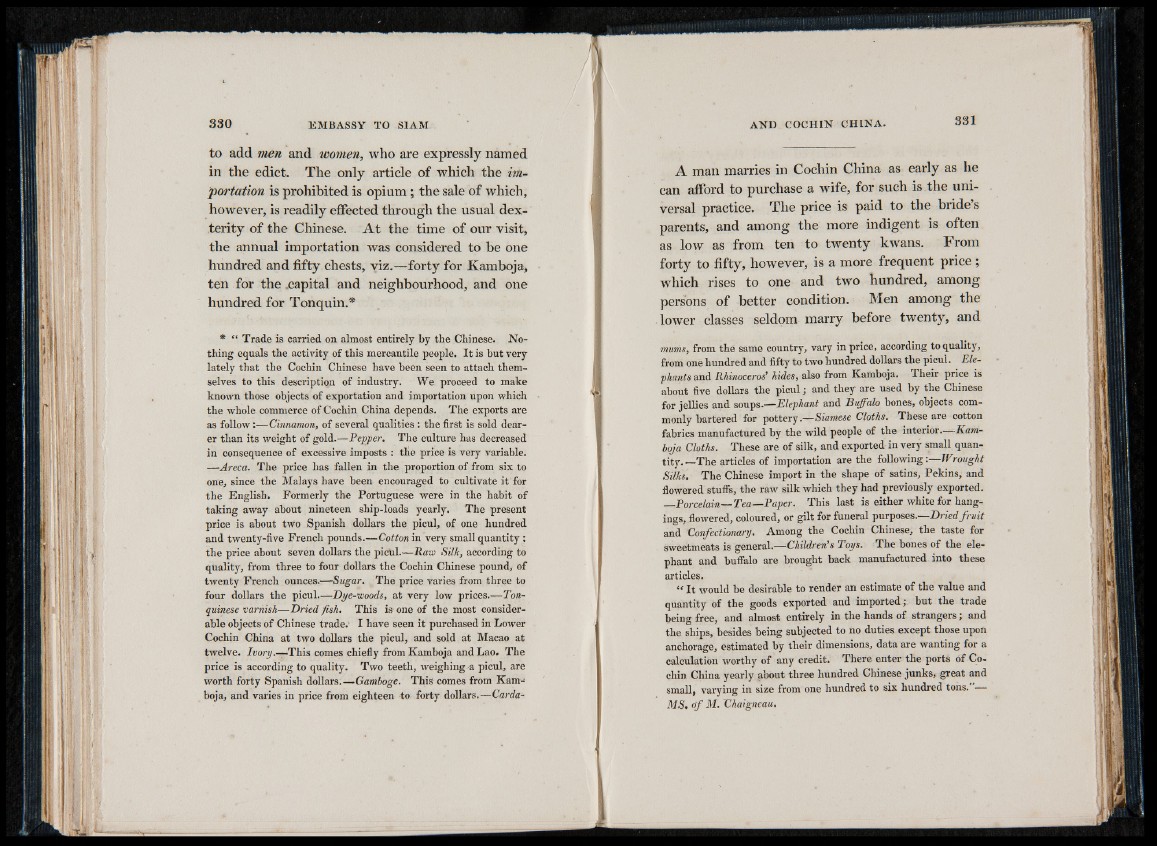
to add men and women, who are expressly named
in the edict. The only article of which the importation
is prohibited is opium; the sale of which,
however, is readily effected through the usual dexterity
of the Chinese. A t the time of our visit,
the annual importation was considered to be one
hundred and fifty chests, viz.—forty for Kamboja,
ten for the .capital and neighbourhood, and one
hundred for Tonquin.*
* “ Trade is carried on almost entirely by the Chinese. Nothing
equals the activity of this mercantile people. It is but very
lately that the Cochin Chinese have been seen to attach themselves
to this description of industry. We proceed to make
known those objects of exportation and importation upon which
the whole commerce of Cochin China depends. The exports are
as follow:—Cinnamon, of several qualities : the first is sold dearer
than its weight of gold.—Pepper. The culture has decreased
in consequence of excessive imposts : the price is very variable.
—Areca. The price has fallen in the proportion of from six to
one, since the Malays have been encouraged to cultivate it for
the English. Formerly the Portuguese were in the habit of
taking away about nineteen ship-loads yearly. The present
price is about two Spanish dollars the picul, of one hundred
and twenty-five French pounds.— Cotton in very small quantity :
the price about seven dollars the picul.—Raw Silk, according to
quality, from three to four dollars the Cochin Chinese pound, of
twenty French ounces.— Sugar. The price varies from three to
four dollars the picul— Dye-woods, at very low prices.— Ton-
quinese varnish—Dried fish. This is one of the most considerable
objects of Chinese trade.' I have seen it purchased in Lower
Cochin China at two dollars the picul, and sold at Macao at
twelve. Ivory.-fThis comes chiefly from Kamboja and Lao. The
price is according to quality. Two teeth, weighing a picul, are
worth forty Spanish dollars.—Gamboge. This comes from Kamboja,
and varies in price from eighteen to forty dollars.—Carda-
A man marries in Cochin China as early as lie
can afford to purchase a wife, for such is the universal
practice. The price is paid to the bride’s
parents, and among the more indigent is often
as low as from ten to twenty kwans. From
forty to fifty, however, is a more frequent price ;
which rises to one and two hundred, among
persons of better condition. Men among the
lower classes seldom marry before twenty, and
mums, from the same country, vary in price, according to quality,
from one hundred and fifty to two hundred dollars the picul. Elephants
and Rhinoceros’ hides, also from Kamboja. Their price is
about five dollars the picul; and they are used by the Chinese
for jellies and soups.—Elephant and Buffalo bones, objects commonly
bartered for pottery.—Siamese Cloths. These are cotton
fabrics manufactured by the wild people of the interior. Kamboja
Cloths. These are of silk, and exported in very small quantity
.—The articles of importation are the following:—Wrought
Silks. The Chinese import in the shape of satins, Pekins, and
flowered stuffs, the raw silk which they had previously exported.
Porcelain—Tea—Paper. This last is either white for hangings,
.flowered, coloured, or gilt for funeral purposes.—Dried fru it
and Confectionary. Among the Cochin Chinese, the taste for
sweetmeats is general.—Children s Toys. The bones of the elephant
and buffalo are brought back manufactured into these
articles.
“ It would be desirable to render an estimate of the value and
quantity of the goods exported and imported j but the trade
being free, and almost entirely in the hands of strangers; and
the ships, besides being subjected to no duties except those upon
anchorage, estimated by their dimensions, data are wanting for a
calculation worthy of any credit. There enter the ports of Cochin.
China yearly about three hundred Chinese junks, great and
small, varying in size from one hundred to six hundred tons.”—
MS. o f M. Vhaigneau.